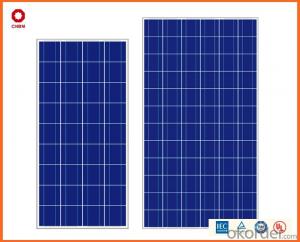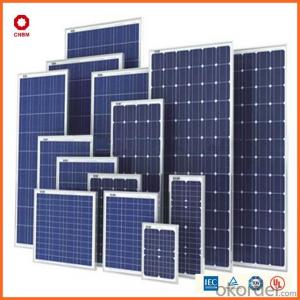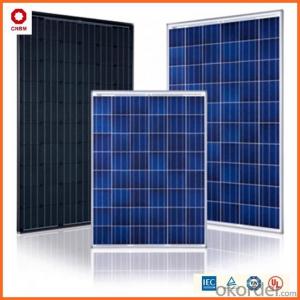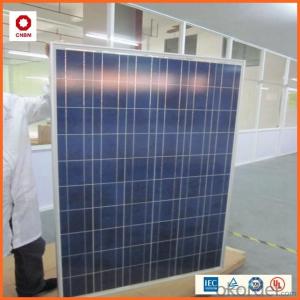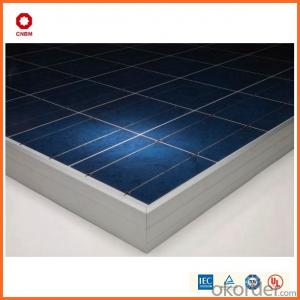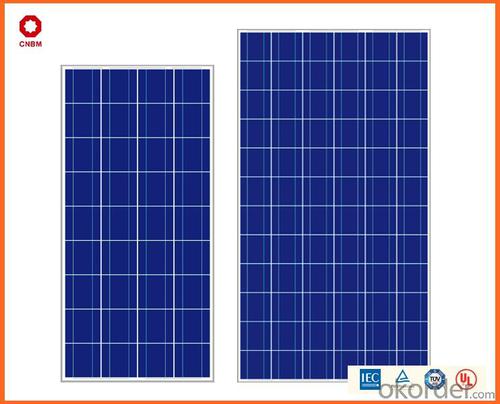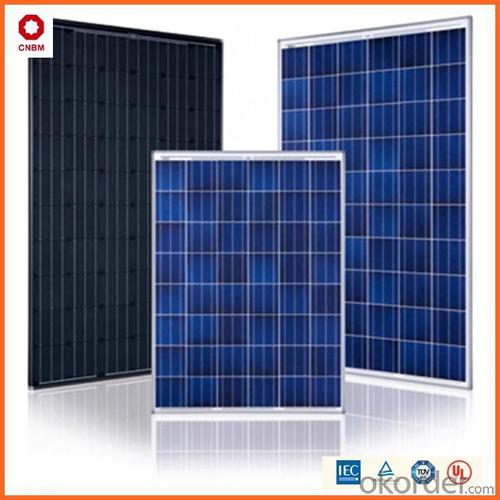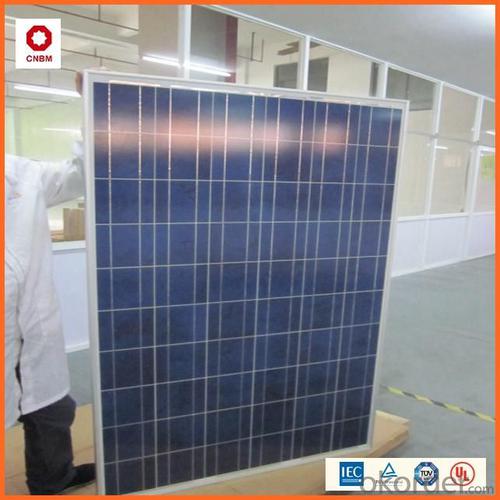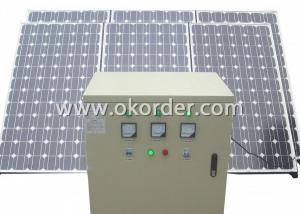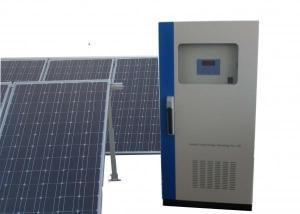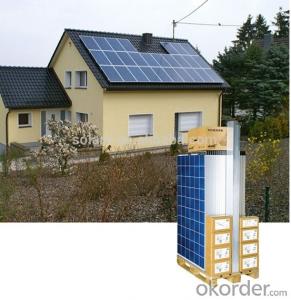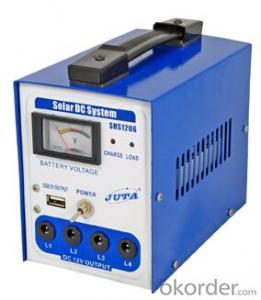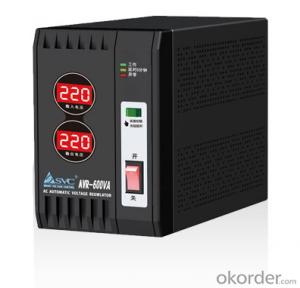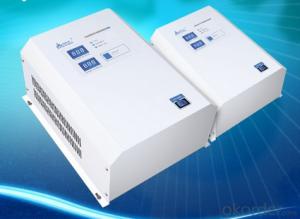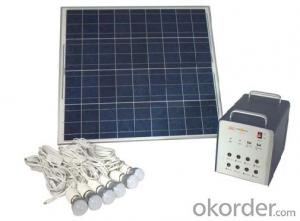305W Poly Solar Panel 0.45/W A Grade - ABCs of Solar Energy Systems
- Loading Port:
- China main port
- Payment Terms:
- TT OR LC
- Min Order Qty:
- 1 watt
- Supply Capability:
- 10000000 watt/month
OKorder Service Pledge
OKorder Financial Service
You Might Also Like
Specification
Product Description:
Hot Sale !!! Quality and Safety of 245w-320w Poly Solar Panel
1. Rigorous quality control meets the highest international standards.
2. High-transmissivity low-iron tempered glass, strong aluminium frame.
3. Using UV-resistant silicon.
4. IS09001/14001/CE/TUV/UL
Warranties of 245w-320w Poly Solar Panel
1. 10 years limited product warranty
2. 15 years at 90% of the minimal rated power output
3. 25 years at 80% of the minimal rated power output
Specification
Characteristics of Poly solar panels CNBM (245-320W) | |||||
Max Power Voltage Vmp(V) | 30.3 | 30.8 | 31.1 | 31.4 | 31.85 |
Max Power Current Imp(A) | 7.60 | 7.64 | 7.73 | 7.81 | 7.85 |
Open Circuit Voltage Voc(V) | 36.1 | 36.6 | 37 | 37.3 | 37.68 |
Short Circuit Current Isc(A) | 8.50 | 8.55 | 8.65 | 8.75 | 8.85 |
Max Power Pm(W) | 230W | 235W | 240W | 245W | 250W |
Temperature Coefficient of Cells Poly solar panels CNBM (245-320W) | |
NOCT | 45 ± 2 |
Temperature Coeffucients of Isc | 0.0492 |
Temperature Coeffucients of Voc | -0.3374 |
Temperature Coeffucients of Voc | -0.4677 |
Mechanical Data of Poly solar panels CNBM (245-320W) | |
Dimension | 1638 × 982 × 40 mm |
Weight | 19.5 kg |
No. of Cells and Connections | 60 (6 ×10) |
Tolerance | 0 ~ + 5 W |
Cell | Monocrystalline Cell 156 × 156 mm |
Packing | 624 Pcs/40ft(H) Container |
Limits of Poly solar panels CNBM (245-320W) | |
Operating Temperature | -40 to +85 |
Storage Temperature | -40 to +85 |
Max System Voltage | 1000VDC(IEC) / 600VDC(UL) |
Features of our products:
• High conversion efficiency mono/poly-crystalline amorphous silicon solar cells
• Modules incorporate high performance bypass diodes to minimize the power drop caused by shading
• High transmittance, low-iron tempered glass
• High performance EVA encapsulant to prevent destroying and water.
• AI frame: without screw, corner connection. 8 holes on the frame can be installed easily
• Good performance of preventing from atrocious weather such as wind and hails
• Certifications: CE IEC TUV VDE UL, Class I
• 10 years 90% power output warranty
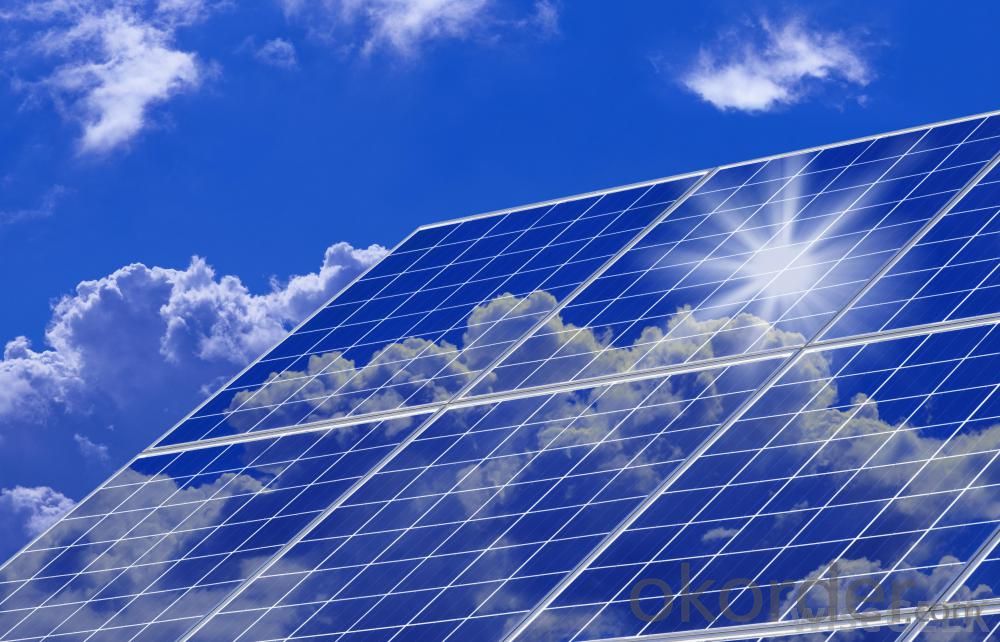
Shipping of 245w-320w Poly Solar Panel
By Sea | Delivery from Shanghai or Ningbo seaport |
By Air | Departure from Shanghai Pudong Airport |
By Express | Post by DHL, EMS, UPS, TNT. |
- Q: Can solar energy systems be used in areas with strict building codes or historical preservation restrictions?
- Yes, solar energy systems can be used in areas with strict building codes or historical preservation restrictions. While it may require some additional planning and design considerations, it is certainly possible to integrate solar energy systems into the existing structures in these areas. One way to incorporate solar energy systems is by using building-integrated photovoltaics (BIPV) or solar thermal systems that are seamlessly integrated into the building's design. These systems can be installed on rooftops, facades, or even as shading elements, ensuring that the historical aesthetics or architectural integrity of the building are not compromised. Furthermore, advancements in solar technology have allowed for the development of more visually appealing solar panels, such as solar tiles or transparent solar windows, which can blend in with the existing building materials. This makes it easier to gain approval from historical preservation boards or building code authorities. It is important to note that in areas with strict building codes or historical preservation restrictions, the approval process for installing solar energy systems may be more complex. It may require obtaining permits, conducting structural assessments, and working closely with local authorities to ensure compliance with regulations. However, with the growing recognition of the importance of renewable energy, many jurisdictions have developed specific guidelines and provisions for integrating solar systems in historic areas. In summary, solar energy systems can be used in areas with strict building codes or historical preservation restrictions by employing BIPV, solar thermal systems, or visually appealing solar panels. While the approval process may be more involved, with proper planning and adherence to guidelines, it is possible to harness solar energy without compromising the architectural or historical significance of the area.
- Q: How does the efficiency of solar panels vary based on the temperature?
- Solar panels' efficiency is subject to variation depending on temperature. In general, solar panels perform better in cooler temperatures, but their efficiency declines as the temperature rises. This phenomenon is attributed to the materials used in solar panels, particularly semiconductor materials like silicon. As the temperature increases, the electrons in the semiconductor material gain more energy, resulting in a rise in the voltage output of the solar panel. However, this increase in voltage does not proportionally enhance the power output, leading to an overall decrease in efficiency. Furthermore, elevated temperatures can amplify the resistance of the electrical conductors within the solar panel, causing power losses and reduced efficiency. This is known as thermal losses. The heightened resistance impedes the flow of electric current, thereby diminishing the overall power output. In addition, high temperatures can trigger the "thermal runaway effect," a phenomenon where the efficiency of the solar panel rapidly declines as the temperature increases. This can pose significant challenges, particularly in regions with hot climates or during heatwaves. To counteract the adverse impact of temperature on solar panel efficiency, advanced solar panel designs incorporate cooling mechanisms. For instance, some panels are equipped with built-in ventilation systems or are elevated to facilitate air circulation underneath, ensuring dissipation of excess heat and maintenance of optimal operating temperatures. To sum up, solar panel efficiency is influenced by temperature fluctuations. While they perform better in cooler temperatures, their efficiency diminishes as the temperature rises due to increased resistance, thermal losses, and the thermal runaway effect. It is crucial to consider these factors during the design and installation of solar panels to maximize their performance and output.
- Q: Can solar energy systems be used for emergency backup power during power outages?
- Yes, solar energy systems can be used for emergency backup power during power outages. Solar panels can generate electricity even when the grid is down, as long as they are connected to a battery storage system. This allows homeowners or businesses to store excess solar energy during the day and use it during an outage. It provides a reliable and sustainable alternative to traditional backup generators, reducing dependence on fossil fuels and ensuring continuous power supply during emergencies.
- Q: Do solar energy systems require batteries?
- No, solar energy systems do not necessarily require batteries.
- Q: Can a solar energy system power an entire home or business?
- Yes, a properly designed and sized solar energy system can power an entire home or business. The system should be tailored to the energy needs of the property, taking into account factors such as energy consumption, available roof or ground space for solar panels, and geographic location to ensure sufficient power generation. With advanced technology and efficient solar panels, it is possible to achieve energy independence and offset the majority, if not all, of the electricity requirements with solar energy.
- Q: Can solar energy systems be installed on ground-mounted structures?
- Yes, solar energy systems can be installed on ground-mounted structures. These structures provide a stable and efficient platform for solar panels, allowing them to be positioned at an optimal angle for capturing sunlight. Ground-mounted systems are often used in areas where roof space is limited or not suitable for installation, making them a popular choice for residential, commercial, and utility-scale solar projects.
- Q: Can solar panels be integrated into building materials like windows or roofing tiles?
- Yes, solar panels can be integrated into building materials like windows or roofing tiles. These integrated solar panels, also known as building-integrated photovoltaics (BIPV), allow for the generation of electricity while being seamlessly incorporated into the design of the building. This integration not only reduces the need for separate solar panels but also enhances the aesthetics and functionality of the building by harnessing solar energy.
- Q: What is the average lifespan of a solar energy system?
- The average lifespan of a solar energy system is typically around 25 to 30 years.
- Q: Can solar energy systems be used in areas with limited resources?
- Yes, solar energy systems can be used in areas with limited resources. Solar power is a renewable energy source that requires no fuel and can be harnessed using simple technologies. It can be particularly beneficial in areas with limited access to traditional energy sources, such as remote regions or developing countries. Solar energy systems can provide electricity for basic needs like lighting, cooking, and powering small appliances, improving the quality of life and promoting sustainable development in resource-constrained areas.
- Q: What is the impact of snow on the performance of solar panels?
- The impact of snow on the performance of solar panels is generally negative. Snow accumulation on the surface of solar panels can block sunlight, reducing their efficiency and power output. Additionally, snow can create a layer of insulation, preventing the panels from generating electricity. However, the angle and tilt of the panels, as well as the temperature, can also influence the impact of snow.
Send your message to us
305W Poly Solar Panel 0.45/W A Grade - ABCs of Solar Energy Systems
- Loading Port:
- China main port
- Payment Terms:
- TT OR LC
- Min Order Qty:
- 1 watt
- Supply Capability:
- 10000000 watt/month
OKorder Service Pledge
OKorder Financial Service
Similar products
Hot products
Hot Searches
Related keywords
